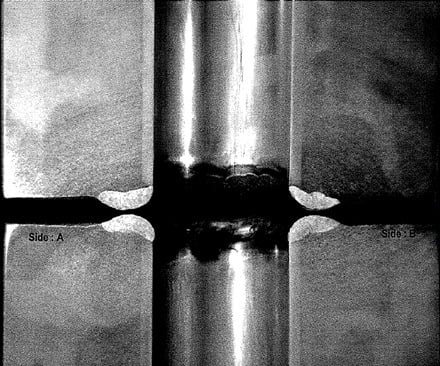In the welding world, quality control isn’t just an optional step—it is the backbone of safety, performance, and reliability. Whether it’s a bridge, pressure vessel, oil pipeline, or aerospace component, every welded joint must be verified for integrity. Among the most widely used destructive testing techniques are macro tests (macroscopic examinations) and micro tests (microscopic examinations).
Both methods may sound similar, but they serve very different purposes and complement each other in ensuring a weld is not only visually sound but also metallurgically reliable under service conditions.
Macro Test (Macroscopic Examination)
Magnification
- Conducted with the naked eye or using a simple magnifying glass, generally up to 10x magnification.

Purpose
- Evaluates large-scale weld features such as:
- Weld bead shape
- Weld penetration depth
- Fusion between base metals and filler
- Location of weld defects (cracks, porosity, slag inclusions, lack of fusion, etc.)
Use
- A quick, cost-effective method used in almost every Procedure Qualification Record (PQR) and research study to confirm that weld geometry meets the required standards.
- Provides an overall health check of the weld before diving deeper into microscopic details.
Example:
If a welder produces a test coupon, a macro test can reveal if the root is fused properly or if a large slag inclusion exists. This ensures the weld passes basic integrity before advanced testing.
Micro Test (Microscopic Examination)
Magnification
- Performed at 100x or higher magnification using an optical microscope or even electron microscopy in advanced studies.

Purpose
- Examines the microstructure of:
- Weld metal
- Heat-Affected Zone (HAZ)
- Base metal
- Detects:
- Grain size and growth
- Microcracks not visible to the naked eye
- Phase transformations (e.g., martensite, ferrite, pearlite, bainite)
- Hardness variations across weld zones
- Tiny inclusions that can cause premature failure
Use
- Essential for high-strength steels, alloy materials, or critical service environments such as:
- Sour service (H₂S environments)
- Cryogenic applications
- Nuclear and aerospace welding
- Helps engineers predict long-term performance, especially under stress, heat cycles, or corrosive conditions.
Example:
Even if a weld looks perfect under a macro test, a micro examination might reveal coarse grains in the HAZ, which could make the weld brittle at low temperatures.
Where They Fit: WPS & PQR
Procedure Qualification Record (PQR)
- Macro tests are almost always required in PQRs to confirm correct geometry, penetration, and fusion.
- Micro tests may be required depending on:
- The welding code (ASME IX, AWS D1.1, ISO 15614, etc.)
- The material type (carbon steel, stainless steel, high alloys)
- The application (nuclear, offshore, oil & gas, structural steel).
Welding Procedure Specification (WPS)
- Macro and micro tests are not performed during WPS drafting itself.
- They are conducted during PQR qualification testing of weld coupons.
- If any essential welding variable changes (e.g., base metal, filler, heat input), fresh PQRs are needed—requiring new macro/micro tests.
Big Picture
Think of it this way:
- Macro Test = A health check-up → Identifies big, visible problems like poor penetration, slag, or porosity.
- Micro Test = A microscopic scan → Identifies hidden weaknesses in microstructure that affect strength, toughness, and durability.
Together, they form a comprehensive quality assurance system that ensures welds are not just defect-free but also fit for long-term performance in service conditions.
Why They’re Essential in Industry
- Structural Steel Fabrication → Macro ensures weld profile meets design, micro ensures toughness in seismic conditions.
- Oil & Gas Pipelines → Macro checks penetration, micro ensures resistance to hydrogen-induced cracking (HIC).
- Pressure Vessels → Macro confirms geometry, micro ensures resistance to creep, stress, and temperature effects.
- Aerospace & Nuclear → Both tests are mandatory, as welds must survive extreme stresses with zero tolerance for failure.
Takeaway
- Macro ensures the weld looks right.
- Micro ensures the weld behaves right.
When combined, they give welding engineers, inspectors, and fabricators the confidence that their welds will perform reliably under the toughest conditions.
